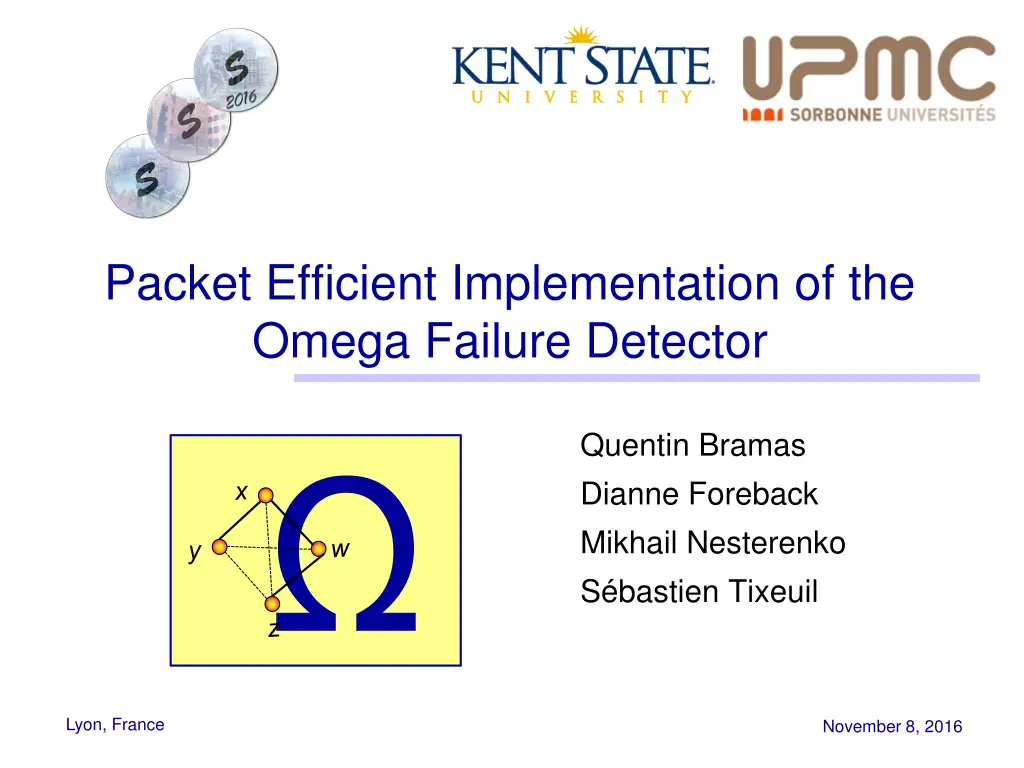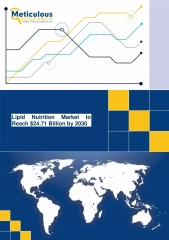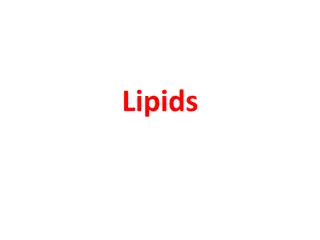
Efficient Implementation of Omega Failure Detector
Explore the concept of Omega as an abstract construct in distributed systems that enables solving otherwise unsolvable problems. Learn about the different levels of efficiency in message and packet distribution, as well as the necessary conditions for implementing Omega in asynchronous system models.
Download Presentation

Please find below an Image/Link to download the presentation.
The content on the website is provided AS IS for your information and personal use only. It may not be sold, licensed, or shared on other websites without obtaining consent from the author. If you encounter any issues during the download, it is possible that the publisher has removed the file from their server.
You are allowed to download the files provided on this website for personal or commercial use, subject to the condition that they are used lawfully. All files are the property of their respective owners.
The content on the website is provided AS IS for your information and personal use only. It may not be sold, licensed, or shared on other websites without obtaining consent from the author.
E N D
Presentation Transcript
Packet Efficient Implementation of the Omega Failure Detector Quentin Bramas Dianne Foreback Mikhail Nesterenko S bastien Tixeuil Lyon, France November 8, 2016
What is Omega? Oracle Abstract construct that enables a solution to an otherwise unsolvable problem in a particular distributed system model Encapsulates the portion of solution that is impossible to implement Consensus requires non-crashed (correct) processes to agree on a value FLP [11]: Consensus is impossible to solve in asynchronous system model even a if single process may crash: impossible to know if a process crashed or is merely slow requires an oracle Omega - an oracle that eventually outputs the same leader at every correct process Weakest failure detector to solve consensus in the asynchronous system model [6] Encapsulates the least amount of synchrony for a solution to Consensus 2
Notation Message contents to be distributed to other processes (using packets) Packet portion of data transmitted across channel Fair-lossy channel - if an infinite number of messages are sent along this channel, an infinite number of messages are received implementation efficiency metrics Message Efficient Implementation: only a single process sends an infinite number of messages and all but finitely many messages are of constant size Packet Efficient Implementation: if all but finitely many messages are transmitted using O(n) packets. Packets of different messages may potentially use different channels the number of used channels is not limited Super Packet Efficient Implementation: requires only a O(n) channels to transmit packets of an infinite number messages the number of used channels is limited 3
Omega Implementations Implementation conditions Omega is impossible to implement in the asynchronous system model Must strengthen the system model with added synchrony and reliability assumptions What is the least restrictive communication model to implement Omega? Aguilera et al. [1] algorithm Requires at least one process to have eventually timely channels to all correct processes Requires a (possibly different) single process to have fair- lossy channels to/from all others Message efficient timely channel drops all packets Delporte-Gallot et al. [9] algorithm determines timely channel graph Can be used to construct Omega Requires at least one process to have timely paths to all correct processes Requires all channels to be reliable Super packet efficient If channel timeliness/reliability is arbitrary, what are the necessary&sufficient conditions for Omega implementation? 4
Single-hop vs. Multi-hop Theorems 1 and 2 (summarized): If timely channel probability is ? < 1 ??? ??? ? ????? then, as network sizengrows, the probability of leader existence using Single-hop direct communication: approaches zero exponentially fast Multiple-hop communication: approaches one exponentially fast Theorems 3 and 4 (summarized): The probability of a leader persisting while the timeliness of channels change Single-hop tends to zero Multiple-hop tends to infinity Practically speaking, a multi-hop omega implementation is far more likely to succeed in establishing a persistent leader v u w x t z y 5
Our Deterministic Results Prove necessary conditions for Omega At least one process (leader) needs to have a timely path to all correct processes All processes have to have a fair-lossy path to the leader Present an algorithm MPO that implements Omega under these conditions the conditions are necessary and sufficient Prove cannot have super packet-efficient algorithm Algorithm of Delporte-Gallot et al. channel reliability requirement is necessary 6
Infinite Number of Messages Theorem 5 and Corollary 1 (summarized): In an implementation of Omega, at least one process needs to send infinitely many timely messages. This process must be the leader. Intuition: The leader needs to periodically inform other processes of its correctness or they will not be able to detect its crash x Why?: Cannot distinguish between crashed and slow process thus toggling between leaders may occur y w Let process x be the leader Let v, w and z crash v z If x stops sending timely messages, y thinks x crashed and elects itself as leader Send messages arbitrarily and now x picks y as leader Repeat as above but with y 7
No Channel Reliability/Timeliness Lemma 1 and Corollary 2 (summarized): If no channel reliability/timeliness properties, to timely deliver a message Each recipient must send it across every outgoing channel (except possibly the channels to the leader and sender) ?2 packets are needed (not packet efficient) Intuition: Cannot establish properties, have to send packets everywhere otherwise might skip be the channel that contains the only timely path leading to some process x y w v z 8
Fair-Lossy Path Lemma 2: In any message efficient implementation of Omega, each correct process must have a fair-lossy path to the leader Intuition: must be able to provide feedback if the leader is no longer timely. Let process x be the leader If y no longer considers x its leader and gets no other messages, y elects itself leader y does not send fair-lossy messages so others do not know of y s decision Thus, no agreement on leader x y w v z 9
Eventually Timely Paths Theorem 6: For a message and packet efficient implementation At least one process x must have an eventually timely path to all correct processes every correct process has a fair-lossy path to the leader Intuition: The leader x must send an infinite number of messages (so others do not think it crashed) If a proportional number of processes do not have timely incoming channels, then all processes must forward each message (per Lemma 2) number of packets required for each message is in ?2 - contradiction x y w v z 10
Our Deterministic Results Prove necessary conditions for Omega At least one process (leader) needs to have a timely path to all correct processes All processes have to have a fair-lossy path to the leader Present an algorithm MPO that implements Omega under these conditions the conditions are necessary and sufficient Prove cannot have super packet-efficient algorithm Algorithm of Delporte-Gallot channel reliability requirement is necessary 11
No Super Packet Efficiency Theorem 7: Even if there the leader has an eventually timely path to every correct process and every correct process has a fair-lossy path to the leader, there does not exist a message and super packet efficient implementation of Omega S2 S1 eventually timely channel L1 L2 x y leader leader w z timely component eventually reliablechannel timely component Intuition: Assume there are an equal number of processes in each component If there is no communication between processes of the two components initially, processes in S1 assume those in S2 are crashed and vice versa Processes in S1 elect L1 from S1 as their leader and processes in S2 elect L1 from S2 as their leader The eventuality of the timely and reliable channels occur after the leaders are elected Thus, the conditions of the theorem exist. Yet, disagreement on the leader occurs 12
Our Deterministic Results Prove necessary conditions for Omega At least one process (leader) needs to have a timely path to all correct processes All processes have to have a fair-lossy path to the leader Present an algorithm MPO that implements Omega under these conditions the conditions are necessary and sufficient Prove cannot have super packet-efficient algorithm Algorithm of Delporte-Gallot channel reliability requirement is necessary 13
MPO Algorithm: Features Leader candidate estimates reliability of channels by building arboresence of timely channels Sends packets over these channels Gets failed messages if untimely Process with lowest weight arborescence wins Weight used to evaluate channel reliability Proceeds in phases to preserve efficiency Messages sent an infinite number of times are of constant size w x x startPhase(x, phase#, arb) alive(x, phase#, shoutID) y y w w X 4 v z v z 14
x Takes Leadership x calculated weight of arbs from all processes and it has the lowest arb x broadcasts startPhase sending the arb to limit the channels being used x startPhase(x, phase#, arb) y w v z 15
Leader x Sends alive Goal: alive timely received by all correct processes according to arborescence per phase#, otherwise, x keeps track of failed to build new arb should it lose leadership w x x alive(x, phase#, shoutID) y w y w X 5 4 v z failed(x,y,z) v z Not timely received by z z broadcasts failed, and increases timer to gauge delay All other processes broadcast z s failed once x receives failed for the first time, increases yz weight used to calculate arbs for next phase (should it lose leadership) Timely received via the arborescence: w, y timely receive x s alive from parent per current phase# (ignore if earlier phase#) y forward alive according to arborescence or shouts (broadcast) w s turn to shout alive v first receives from non-parent w, waits to receive from parent y (or turns on timer if it was off) 16
x timeout Expires : Is x Still the Leader? x calculates new arb considering updated edge weights of untimely channels x still a leader: If arb is smaller than other processes arbs Message efficient: uses old arb and never updates phase # (no need to send a new arb to all) x loses leadership: Increases its phase# broadcasting stopPhase Message Efficient: stopPhase with newer phase# used by other processes to turn off their timer for x and to quit sending failed x stops sending alive x keeps own timer on to check if regains leadership Kept leadership Use old arb, send alive Timeout expires Calculate new arb Lost leadership Broadcast stopPhase x x x stopPhase(x; phase#) y y w y w w 5 v v z z v z 17
x Regains Leadership x arb is once again smaller than others Other leader must have sent stopPhase due to non-timely channels x x startPhase(x; phases[x]; arbs[x]) alive(x, phase#, shoutID) y y w w v z v z xtimeout expires (process own timer is always on) x kept collecting failed messages updating its edges calculates its new arb x broadcasts startPhase with new arb to all other processes So other processes will await alive messages and send failed if not timely received from parent according to new arb 18
MPO Algorithm Message and Packet Efficient Message Efficient: Only a single process x sends an infinite number of messages and all but finitely many messages are of constant size w x alive(x, phase#, shoutID) Non-constant message, startPhase, sent finite times y w v z Packet Efficient: All but finitely many messages are transmitted using O(n) packets Packets of different messages may potentially use different channels Thus, the number of used channels is not limited w x alive(x, phase#, shoutID) Eventually, only 2 ? 1 packets sent y w Broadcast precludes super packet efficiency of O(n) channels v z 19
Packet Efficient Implementation of the Omega Failure Detector Thank you! Questions? Lyon, France November 8, 2016






















